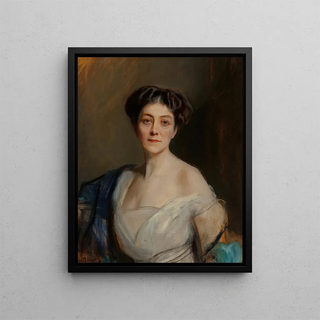Art print | A portrait of Caroline Lambart, Countess of Cavan - Philip Alexius de László


View from behind

Frame (optional)
An art print of Caroline Lambart, Countess of Cavan - Philip Alexius de László – Engaging introduction
In the fascinating world of portrait painting, the work "An art print of Caroline Lambart, Countess of Cavan" by Philip Alexius de László stands out as an iconic masterpiece from the early 20th century. This piece, imbued with rare delicacy, captures not only the beauty of its model but also the essence of an era when art and high society were closely intertwined. The Countess of Cavan, a figure of British nobility, is depicted with a grace that transcends a simple portrait, evoking psychological depth and a rich personal history. Viewing this work invites the observer to delve into the intimacy of the countess, to feel the emotions that animate her, and to ponder the world around her.
Style and uniqueness of the work
Philip Alexius de László's style is distinguished by its realistic approach and mastery of pictorial techniques. In this art print, the subtle nuances of color and the finesse of details demonstrate meticulous observation of the model. Caroline Lambart's gaze, both penetrating and melancholic, seems to capture the very soul of the countess, while the drapery of her dress, delicately rendered, adds a tactile dimension to the composition. László manages to balance realism with a touch of romanticism, creating an atmosphere that invites contemplation. The interplay of light and shadow accentuates the features of the countess's face, making her almost alive, as if she might animate under the viewer's gaze. This balance between precision and emotion makes this work a perfect example of László's exceptional talent.
The artist and his influence
Philip Alexius de László, of Hungarian origin, established himself as one of the most sought-after portraitists of his time. His career, marked by prestigious commissions from nobility and the upper bourgeoisie, demonstrates his skill in capturing not only the physical appearance of his models but also their character and social status.

Matte finish

View from behind

Frame (optional)
An art print of Caroline Lambart, Countess of Cavan - Philip Alexius de László – Engaging introduction
In the fascinating world of portrait painting, the work "An art print of Caroline Lambart, Countess of Cavan" by Philip Alexius de László stands out as an iconic masterpiece from the early 20th century. This piece, imbued with rare delicacy, captures not only the beauty of its model but also the essence of an era when art and high society were closely intertwined. The Countess of Cavan, a figure of British nobility, is depicted with a grace that transcends a simple portrait, evoking psychological depth and a rich personal history. Viewing this work invites the observer to delve into the intimacy of the countess, to feel the emotions that animate her, and to ponder the world around her.
Style and uniqueness of the work
Philip Alexius de László's style is distinguished by its realistic approach and mastery of pictorial techniques. In this art print, the subtle nuances of color and the finesse of details demonstrate meticulous observation of the model. Caroline Lambart's gaze, both penetrating and melancholic, seems to capture the very soul of the countess, while the drapery of her dress, delicately rendered, adds a tactile dimension to the composition. László manages to balance realism with a touch of romanticism, creating an atmosphere that invites contemplation. The interplay of light and shadow accentuates the features of the countess's face, making her almost alive, as if she might animate under the viewer's gaze. This balance between precision and emotion makes this work a perfect example of László's exceptional talent.
The artist and his influence
Philip Alexius de László, of Hungarian origin, established himself as one of the most sought-after portraitists of his time. His career, marked by prestigious commissions from nobility and the upper bourgeoisie, demonstrates his skill in capturing not only the physical appearance of his models but also their character and social status.






